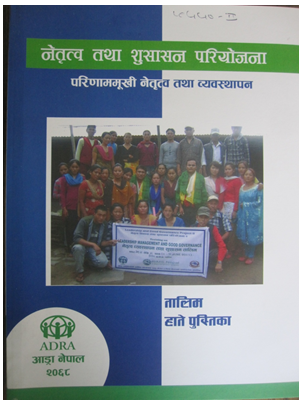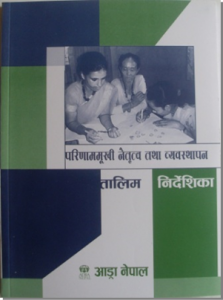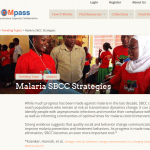The Amazing Staying Power of the Leadership Development Program in Nepal
Have you ever wondered what happens after a project activity ends? Although we are always deeply committed to local ownership and sustainability, we rarely have the opportunity to do long term follow up or reflection. I have recently had the extraordinary opportunity to discover for myself the long term impact of the Leadership Development Program (LDP) in Nepal.
To sum it up in one word: WOW!
MSH’s Leadership, Management, and Sustainability Project (LMS), funded by USAID, introduced and implemented the LDP in Nepal with our partner, ADRA, in 2006-2007. This year, the Health Communications Capacity Collaborative (HC3) project, funded by USAID and led by Johns Hopkins Center for Communication Programs (JHU∙CCP), has started a field project in Nepal. Based on their knowledge of the LDP in Egypt, JHU∙CCP invited its partner, Management Sciences for Health (MSH), to explore launching an LDP focused on family planning communications. I have recently returned from the initial visit, working closely with the HC3 team and our local lead facilitator for the LDP, Dr. Tatwa Timsina. Tatwa, originally trained in LDP by Sylvia Vriesendorp during LMS, works with the Institute of Cultural Affairs (ICA) Nepal which both conducts LDPs and trains facilitators. Tatwa explained to me that the LDP (called ROLDP in Nepal – Results Oriented LDP) was very much alive and well in Nepal. Tatwa identified five organizations currently implementing ROLDP so we invited them to share their experiences.
Seven people from four organizations gathered for a discussion and here’s what we learned:
ADRA: Based on their LMS experience, ADRA adopted ROLDP as their approach in all their projects in health and other sectors, including agriculture, irrigation, economic empowerment, etc. They have multiple donors and projects and work in 30 of the 75 districts There are currently 265 ‘challenge projects’ underway and they have recently trained 26 new facilitators in preparation for further expansion. Hundreds of communities have raised millions of rupees and implemented projects to address their challenges and improve their lives and well-being. From their implementation experience, ADRA has retained the LDP as designed while adding some improvements. For example, their challenge teams don’t just do a results presentation, but undergo a much more thorough ‘social audit’ in which community leaders oversee and monitor their projects.
Further spread: The LDP spread beyond ADRA when one of their key technical staff, Ashok Shrestha, left ADRA to start his own NGO, Community Development and Relief Agency (CDRA). Additionally, Ashok is the president of a Rotary chapter and the country representative for the Goodwill Community Foundation. In all three, he is using LDP widely and has a long list of LDP team challenges and successes. One example that stands out is his use of the LDP approach with a community to get the government to commit 40 million rupees (about $400,000) to build a road to a new eye hospital that Rotary International had helped fund. Ashok also described raising forty six thousand dollars in the US to build a suspension bridge for kids to go to school, then worked with two neighboring communities to persuade the government to match the funds so they could build two bridges. Many kids can now go to school that couldn’t before.
Yet another LDP advocate, Prakash Dhakal, who was trained by ICA, has taken the LDP to the agriculture sector where it’s now being used by the Small Farmer Agricultural Coop Federation (SFACF). The ROLDP helps groups of small farmers to identify and address challenges in production, transport, and marketing of their produce. Prakash has conducted 23 ROLDP trainings! He observed that the most important things were participant selection and problem identification. “If we know the problem we can solve it.” And it goes on. Two other implementing organizations were not able to join us. Hare Ram Bhattarai, formerly a long time MSHer and LDP champion, let us know that they are using LDP in an FHI360 family planning social marketing project called Ghar Ghar Maa Swasthya (“Healthy Homes”).
The implementers praised the simplicity of the LDP (Challenge Model, L+M Framework, etc.) as excellent and usable at all levels. They especially appreciated the resource guide, Managers Who Lead, which ADRA had translated into Nepali during LMS. ADRA has subsequently developed several other publications only in Nepali (training manual; good governance and gender) booklet. The other programs will now be able to benefit from the work ADRA and MSH started.
Ashok and the other implementers observed as that one of reasons for the staying power of the LDP in Nepal has been its effectiveness for communities to access funds for their priority projects. The Government of Nepal’s Ministry of Local Development has an ample budget for communities BUT they are not pro-active in its distribution. Communities have to approach the GON to access the funds and use the right process or they don’t get any funds. ROLDP has enabled communities to define and articulate their challenges, develop projects, identify their stakeholders, and approach them with compelling proposals. The format that ADRA uses to describe and document the challenge projects has been so successful in accessing funds from GON that GON is now encouraging others to use it. It’s definitely a win-win: the ministry appreciates this because their improved funding distribution level gives them a higher effectiveness “score” within the government.
Staying connected: The group of implementers concluded that an excellent follow up activity would be to develop a data base of who is doing what ROLDPs where, to understand its reach, uses, and results. As HC3 starts their LDPs, it will be important to know if they are in the same districts, if people are already familiar with LDP, or participating in one, what the community expectations are for oversight, etc.
As the Nepal experience so vividly demonstrates, the LDP has an energy of its own, enabling groups at various levels and in multiple sectors to do exactly what it is intended to do – identify and overcome challenges and achieve their measurable results to improve their lives. We have created LeaderNet as a space for people to come back together and talk about their LDP experiences, share their results and resources. As adaptations are made, programs rolled out in various sectors, and new translations made, LeaderNet can be THE place where people share these resources and ideas and get feedback and support from this global community. Please join our community.
As you can tell, my discovery of the “staying power” of the LDP long after LMS ended was energizing and inspiring. What long term impact of the LDP have you seen or experienced? In what sector are you applying the LDP? We’d love to hear from you.










Leave a Reply
Want to join the discussion?Feel free to contribute!